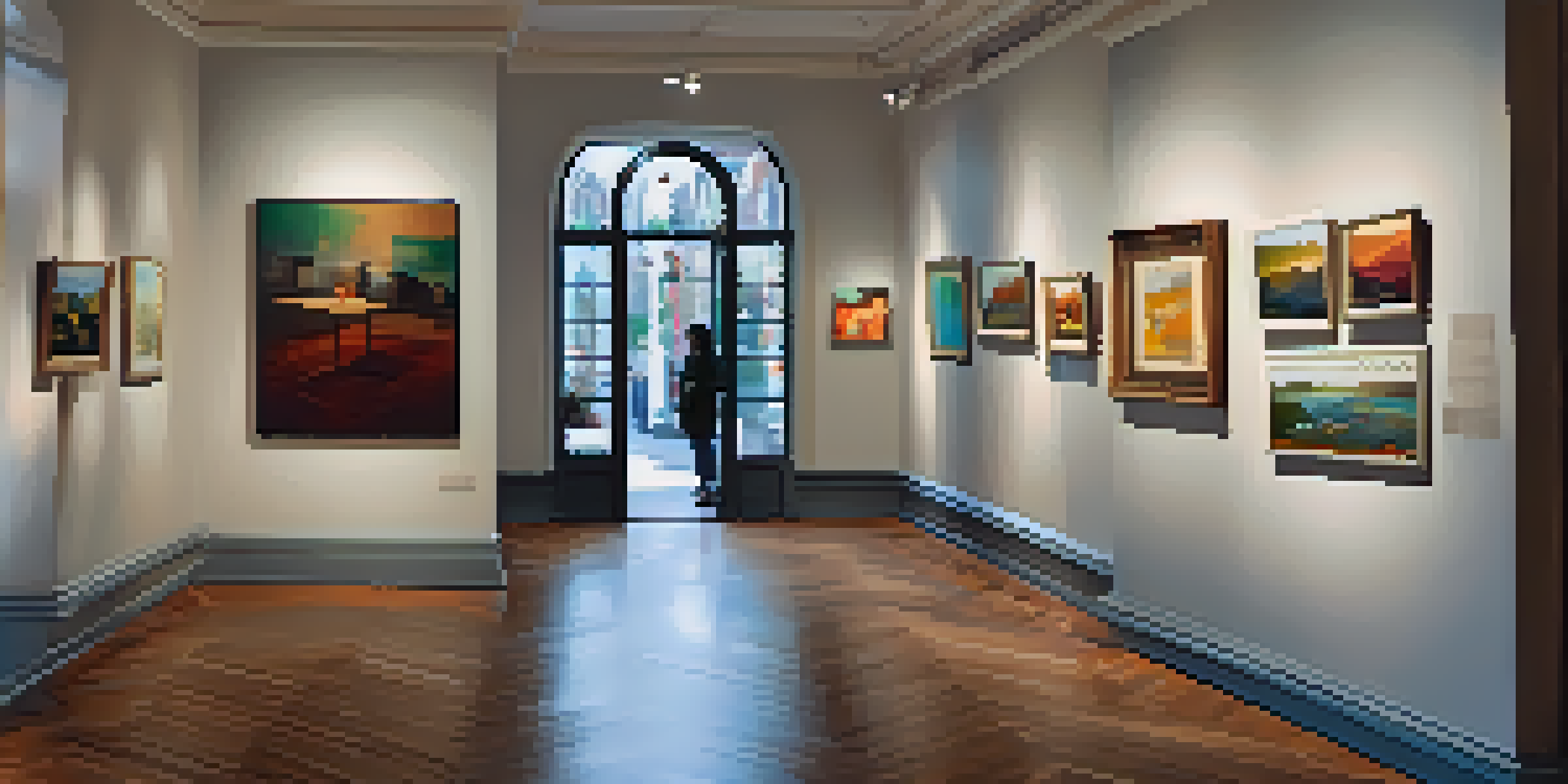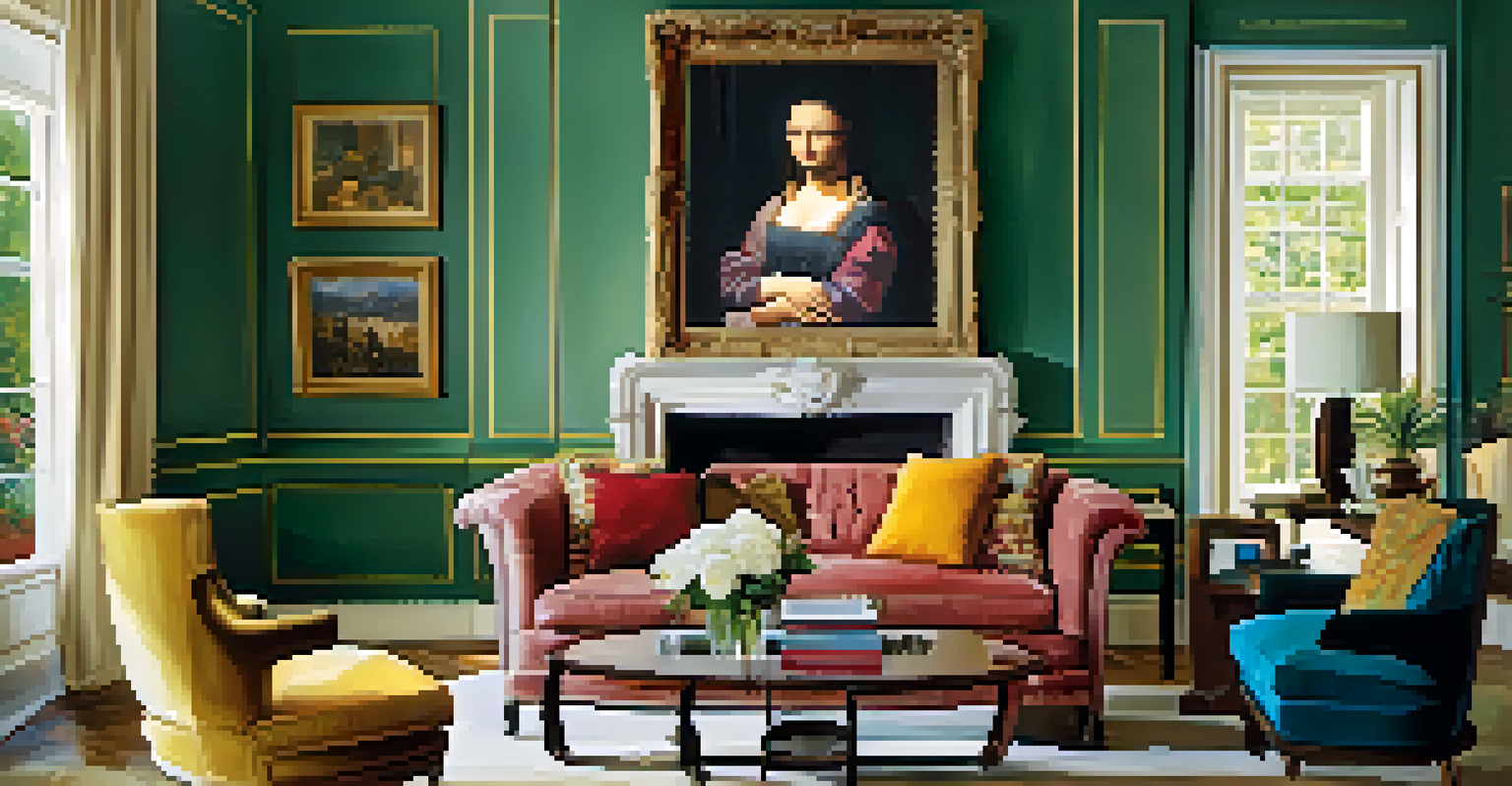Assessing the Value of Original Art vs. Reproductions Today

Understanding Original Art: A Unique Investment
Original art refers to one-of-a-kind pieces created by an artist, often embodying their unique style and vision. These pieces can include paintings, sculptures, and mixed media, each carrying a story and intention that reproductions simply cannot replicate. Investing in original art often means not just acquiring a piece, but also supporting the artist's craft and legacy.
Art is not freedom from discipline, but disciplined freedom.
The value of original art goes beyond mere aesthetics; it often appreciates over time, becoming a potential financial asset. Collectors are drawn to the thrill of owning something that no one else has, which can create a deeper emotional connection to the artwork. This personal engagement is a significant factor that enhances the perceived value of original pieces.
Moreover, original art can serve as a conversation starter, sparking interest and admiration among visitors to your home or office. Each original work holds a history and a narrative, providing a unique backdrop for personal stories and interactions. This aspect of ownership is something reproductions—no matter how high-quality—simply cannot offer.
The Allure of Reproductions: Accessibility and Affordability
Reproductions are copies of original artworks, often produced using various printing techniques. They allow art enthusiasts to enjoy famous pieces without the hefty price tag associated with an original. This accessibility democratizes art, enabling a broader audience to appreciate and display artistic works in their spaces.

While reproductions may lack the unique charm of original pieces, they can still be visually stunning and serve as excellent decor. Many companies produce high-quality reproductions that closely mimic the colors and textures of the originals, making them appealing options for those on a budget. This means that even if you can't afford an original, you can still fill your home with beautiful art.
Original Art: Unique Investment
Investing in original art not only supports the artist but also provides a potential financial asset that appreciates over time.
Additionally, reproductions often come in various sizes and formats, giving buyers the flexibility to find pieces that fit their personal style and space requirements. This adaptability makes them a popular choice for temporary displays or for those who enjoy changing their decor frequently. Overall, reproductions offer a viable solution for art lovers who want to enhance their environment without breaking the bank.
Evaluating Artistic Value: Emotional vs. Monetary
When assessing art, emotional value often plays a crucial role, especially with original pieces. The connection to the artist’s story, the creative process, and the unique characteristics of the work can evoke powerful feelings that impact how we value art. This emotional engagement is often less pronounced with reproductions, which may be perceived as mere decor rather than meaningful investments.
Every artist was first an amateur.
On the flip side, reproductions can still provide joy and satisfaction, especially when they resonate with personal tastes or memories. They allow people to enjoy the aesthetics of famous works without the emotional baggage of investment. This makes reproductions a compelling choice for many who appreciate art, albeit with a different lens than that of original collectors.
Ultimately, the assessment of value—whether emotional or monetary—varies from person to person. Some may prioritize the investment aspect of original art, while others may find equal joy in the beauty of reproductions. It's this individuality in perception that shapes the ongoing conversation about the value of art in our lives.
Market Trends: The Rising Demand for Original Art
In recent years, there has been a notable resurgence in interest toward original art, especially among younger collectors. This shift is driven by a desire for authenticity and a connection to the creative process. Many millennials and Gen Z buyers are eager to support living artists and invest in pieces that reflect their values and individual tastes.
This trend is also fueled by the accessibility of online platforms that showcase original works from a diverse range of artists. Virtual galleries and social media have made it easier for collectors to discover emerging talents and purchase pieces directly from creators. This direct connection empowers artists while allowing collectors to build meaningful collections.
Reproductions: Accessible Art
Reproductions democratize art by allowing a broader audience to enjoy and display beautiful works without the high costs of originals.
As the demand for original art grows, so does its perceived value in the marketplace. Emerging artists often see their prices rise as they gain recognition and support, making early investments potentially lucrative. This dynamic creates an exciting landscape for art buyers, blending passion with the possibility of financial return.
The Role of Technology in Art Reproduction
Technology has significantly transformed the way art is reproduced, with advancements enabling incredibly high-quality prints. Techniques such as giclée printing use archival inks and fine art papers to create reproductions that closely resemble the original works. This level of quality appeals to many art lovers, bridging the gap between affordability and aesthetic appeal.
Digital platforms also allow artists to create limited edition prints, where only a certain number of reproductions are made. These limited editions can carry more value due to their scarcity, much like original works. This hybrid approach makes it possible for collectors to own a piece of the artist’s work without the full financial commitment of an original.
Additionally, the internet has opened up new avenues for artists to reach their audiences, leading to a wider appreciation for both original art and reproductions. Online marketplaces enable consumers to compare pieces from various artists and find works that speak to them, enhancing the overall art-buying experience. Technology thus plays a pivotal role in shaping the contemporary art landscape.
Cultural Significance: Original Art vs. Reproductions
The cultural significance of original art often stems from its ability to capture a moment in time, reflecting societal values, struggles, and triumphs. Many original pieces serve as historical artifacts, offering insights into the artist's intentions and the context in which they were created. This depth of meaning can elevate original art beyond mere decoration, making it a point of cultural conversation.
In contrast, reproductions can sometimes be viewed as diluted versions of the original, lacking the historical context and depth that come with the artist’s unique touch. However, they can still serve an important function in spreading awareness of significant works and making art accessible to a wider audience. The presence of reproductions in public spaces can inspire appreciation for art and even encourage people to seek out original pieces.
Personal Preference in Art Choices
Choosing between original art and reproductions ultimately depends on personal taste, budget, and the emotional connection to the artwork.
Ultimately, both original art and reproductions contribute to the cultural tapestry of our society. While originals may hold a certain gravitas, reproductions play a vital role in democratizing art and making it part of everyday life. Together, they create a rich dialogue about the nature of art and its place in our culture.
Making the Right Choice: Finding Your Art Style
Deciding between original art and reproductions often comes down to personal preference and budget. If you’re drawn to the idea of investing in a unique piece that resonates with you on a deeper level, original art may be the way to go. Consider visiting local galleries or art fairs to discover works that truly speak to you.
On the other hand, if you’re looking for something to enhance your space without a significant investment, reproductions offer a wide range of options that can suit various aesthetic preferences. They can easily complement your decor while allowing for flexibility in your art choices. You might find a reproduction that fits your style perfectly without the commitment of an original.

Ultimately, your art journey is a personal exploration. Whether you choose to invest in original pieces or enjoy the beauty of reproductions, what matters most is that the artwork you select resonates with you. Art should bring joy, provoke thought, and inspire creativity, regardless of its origin.